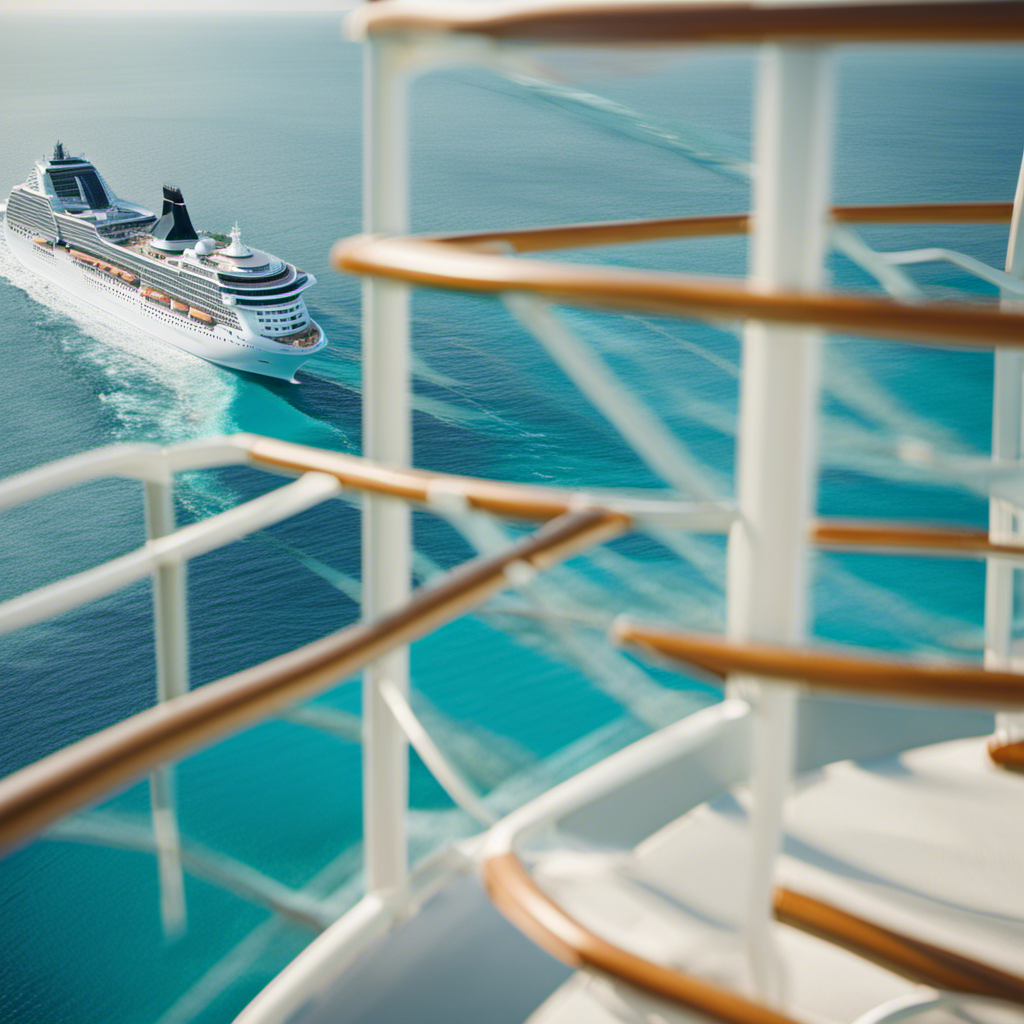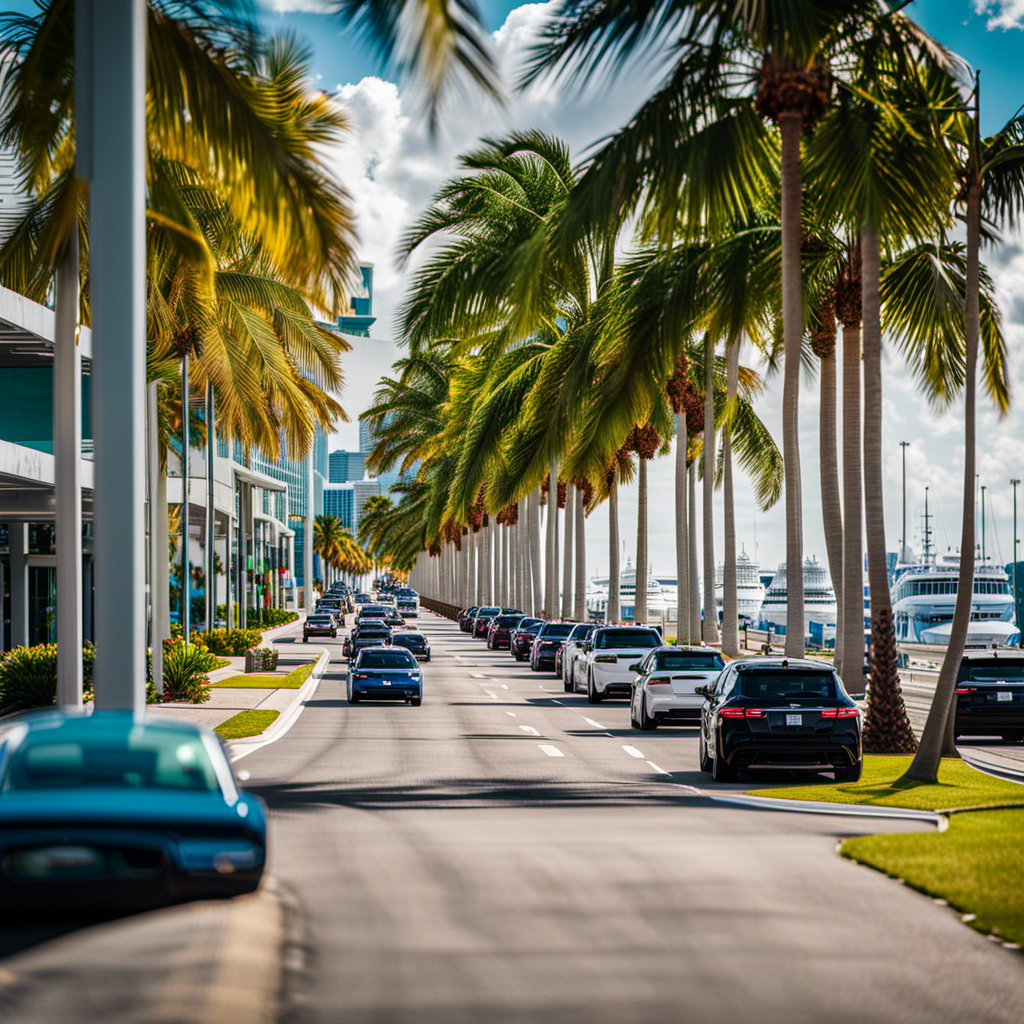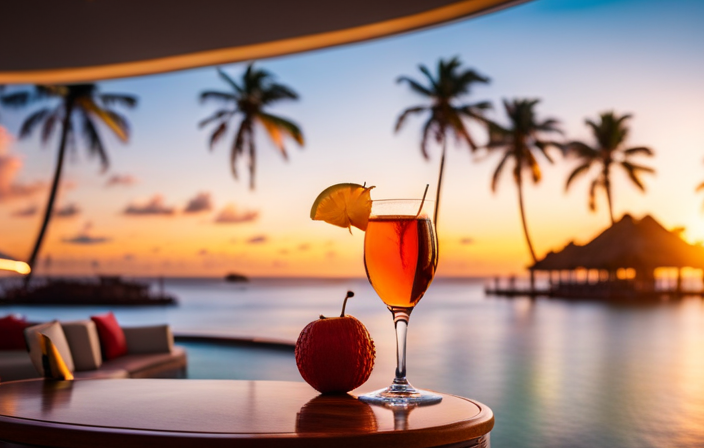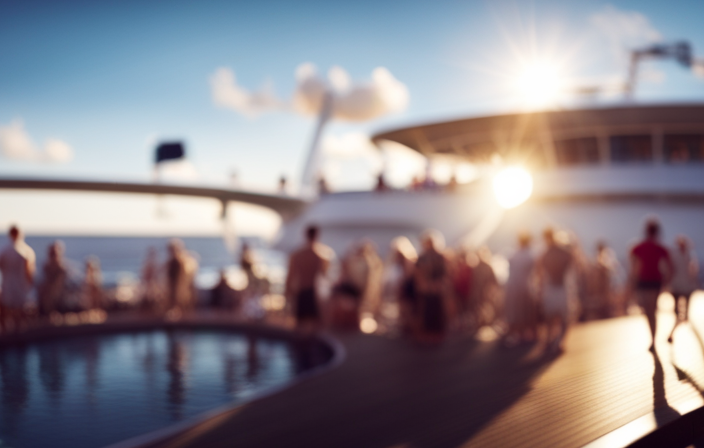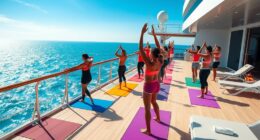I’ve consistently nurtured the aspiration of embarking on a cruise adventure, however, the apprehension of managing seasickness has held me back. The idea of spending days experiencing nausea and discomfort is enough to give someone pause.
That’s why I’ve done my research and discovered some effective strategies to avoid seasickness on a cruise. From choosing the right ship to packing the right medications, I’ll guide you through everything you need to know to ensure a smooth and enjoyable journey on the high seas.
Key Takeaways
- Booking a larger ship with advanced stabilizers can reduce the likelihood of seasickness.
- Taking advantage of amenities like gyms, pools, and indoor activities can distract and stabilize the senses.
- Natural remedies such as ginger, acupressure wristbands, fresh air, and focusing on the horizon can significantly reduce the chances of experiencing seasickness.
- Avoiding alcohol and greasy foods, staying hydrated, taking breaks and resting, engaging in gentle exercise, and managing stress and anxiety can all help prevent seasickness.
Understanding Seasickness
To avoid seasickness on a cruise, it’s important to understand what causes it. Seasickness occurs when your inner ear, responsible for balance, senses motion that your eyes don’t see. This sensory conflict can lead to nausea, dizziness, and vomiting.
However, there are steps you can take to minimize the risk. Firstly, consider booking a cruise on a larger ship with advanced stabilizers. These ships tend to have smoother rides, reducing the likelihood of seasickness.
Additionally, take advantage of the amenities offered on the cruise ship. Many ships have stabilizing features like gyms, pools, and indoor activities to help distract and stabilize your senses.
Lastly, when planning your itinerary, consider booking a shore excursion that involves less time at sea. This will give your body a break from constant motion.
By understanding the causes of seasickness and taking these precautions, you can enjoy your cruise without the discomfort.
Now, let’s explore how choosing the right cruise ship can further enhance your experience.
Choosing the Right Cruise Ship
When picking a cruise ship, make sure you research and select the one that best suits your preferences. It’s important to consider the amenities and itineraries offered by different cruise ships.
Some ships may have a wide range of amenities, such as multiple pools, restaurants, and entertainment options, while others may have a more relaxed and intimate atmosphere.
Additionally, you should take into account the itineraries offered by the cruise ships. Do you prefer a tropical beach getaway or a cultural and historical exploration? Each cruise ship will have its own unique set of itineraries, so make sure to choose one that aligns with your desired destinations.
By carefully considering these factors, you can ensure that your cruise experience is enjoyable and tailored to your specific preferences.
Now, let’s move on to selecting the best cabin location.
Selecting the Best Cabin Location
For the best cabin location, consider choosing a room on a higher deck to enjoy better views and less noise.
When it comes to cabin selection, the location of your room can greatly impact your overall cruise experience, including your ability to prevent seasickness. By opting for a cabin on a higher deck, you not only get to enjoy stunning views of the ocean, but you also minimize the chances of experiencing noise disturbances from the lower decks.
Being able to see the horizon and feel the gentle sway of the ship can help alleviate any feelings of motion sickness.
Now that you have selected the best cabin location, let’s move on to the next important aspect of preventing seasickness: packing the right medications.
Packing the Right Medications
When it comes to preventing motion sickness, there are a few key points to keep in mind.
First, it’s important to choose the right cabin location, as certain areas of the ship can be more prone to causing seasickness.
Second, having the essential medications on hand can make a big difference in managing symptoms. To ensure you’re prepared, it’s crucial to have an accurate and comprehensive medication checklist.
Motion Sickness Prevention
To avoid seasickness on a cruise, you’ll want to try motion sickness prevention methods. Here are some natural ways to prevent seasickness:
-
Ginger: Ginger has been used for centuries to alleviate nausea and can be consumed as ginger tea, ginger candies, or even ginger capsules.
-
Acupressure wristbands: These wristbands apply pressure to specific points on the wrist that can help relieve motion sickness symptoms.
-
Fresh air: Staying in well-ventilated areas and getting fresh air can help reduce feelings of nausea.
-
Focus on the horizon: Keeping your gaze fixed on a stable point on the horizon can help your brain adjust to the motion of the ship.
By incorporating these motion sickness remedies, you can significantly reduce the chances of experiencing seasickness on your cruise.
Now, let’s move on to the essential medication checklist.
Essential Medication Checklist
In preventing motion sickness, medication is often the go-to solution for many people. However, if you prefer to explore medication alternatives or natural remedies, there are several options available. These alternatives can be effective in reducing the symptoms of seasickness without the potential side effects of medication.
Here is a checklist of some natural remedies that you may consider trying:
| Remedy | Description | How to Use |
|---|---|---|
| Ginger | Known for its anti-nausea properties | Chew on ginger candies or drink ginger tea |
| Peppermint | Soothing and can help alleviate nausea | Inhale peppermint oil or drink peppermint tea |
| Acupressure | Stimulates pressure points to relieve symptoms | Use wristbands or apply pressure with your fingers |
| Vitamin B6 | May help reduce the severity of nausea | Take a vitamin B6 supplement or eat foods rich in B6 |
Trying natural remedies can be a great alternative for those who prefer a more holistic approach to preventing seasickness. Now let’s explore some of these remedies further and see how they can help alleviate the symptoms of motion sickness.
Trying Natural Remedies
When it comes to finding natural remedies for nausea, there are a few key points to consider.
First, ginger has long been known for its ability to calm the stomach and reduce feelings of nausea. Whether taken in tea, capsules, or even as ginger candy, it can provide relief for many people.
Additionally, acupressure wristbands can be effective in alleviating nausea by applying pressure to specific points on the wrist.
Lastly, some essential oils, such as peppermint or lavender, have been found to have soothing properties that can help ease nausea when applied topically or inhaled.
Ginger for Nausea
Take a ginger supplement or drink ginger tea to relieve nausea while on a cruise. Ginger has long been used as a natural remedy for digestive issues, including motion sickness. Here are four reasons why ginger is an effective option for combating seasickness:
-
Natural anti-nausea properties: Ginger contains compounds that can help soothe an upset stomach and reduce feelings of nausea.
-
Easy to consume: Ginger supplements and ginger tea are readily available and convenient to take, making them a practical choice for travelers.
-
Safe and well-tolerated: Ginger is generally considered safe for most people and has minimal side effects when consumed in moderate amounts.
-
Scientifically supported: Several studies have shown that ginger can effectively reduce symptoms of nausea and vomiting, making it a reliable option for preventing seasickness.
Transitioning to the next section, another effective way to alleviate motion sickness is by using acupressure wristbands.
Acupressure Wristbands
Wearing acupressure wristbands can be an effective method for reducing nausea and vomiting caused by motion sickness. These wristbands work by applying pressure to specific points on the wrist that are believed to relieve symptoms of nausea.
Acupressure is a traditional Chinese medicine technique that has been used for centuries to promote healing and alleviate various ailments. Acupressure wristbands are a convenient and non-invasive alternative treatment for motion sickness, particularly for those who prefer natural remedies or want to avoid the side effects of medication.
By stimulating the pressure points on the wrist, these wristbands help to calm the stomach and reduce the feelings of queasiness that often accompany motion sickness.
However, if you’re looking for other natural remedies, essential oils for relief can also be an effective option.
Essential Oils for Relief
If you’re experiencing motion sickness, using essential oils for relief can be a natural and effective option. Essential oils have been used for centuries for their various benefits, and they can be helpful in alleviating symptoms of motion sickness.
Here are four essential oils recipes that you can try:
-
Peppermint oil: Known for its soothing properties, peppermint oil can help ease nausea and promote relaxation.
-
Ginger oil: Ginger has long been used to settle upset stomachs, and ginger oil can be just as effective in reducing motion sickness symptoms.
-
Lavender oil: Lavender has a calming effect on the mind and body, making it useful for relieving anxiety and queasiness.
-
Lemon oil: The fresh and citrusy scent of lemon oil can help uplift your mood and reduce feelings of nausea.
By incorporating these essential oils into your routine, you can find relief from motion sickness naturally.
Now, let’s explore another method to prevent seasickness: avoiding alcohol and greasy foods.
Avoiding Alcohol and Greasy Foods
You should definitely avoid alcohol and greasy foods if you want to prevent seasickness on a cruise. Alcohol can exacerbate the symptoms of seasickness and make you feel even more nauseous. Additionally, greasy foods can be harder to digest and may contribute to an upset stomach.
It is important to follow the alcohol restrictions and dietary guidelines set by the cruise ship to ensure a smooth sailing experience. Instead, opt for lighter, easily digestible meals that are rich in fruits and vegetables. These foods can help settle your stomach and provide the necessary nutrients to keep you energized throughout the trip.
By avoiding alcohol and greasy foods, you can significantly reduce your chances of experiencing seasickness on a cruise.
Now, let’s move on to the next important factor in preventing seasickness: staying hydrated.
Staying Hydrated
To prevent dehydration while sailing, it’s crucial to drink plenty of water throughout your trip. Dehydration can lead to fatigue, dizziness, and even heatstroke, so staying hydrated is of utmost importance. Here are three reasons why water is essential for preventing dehydration:
-
Replenishes lost fluids: When you’re out on the open sea, the sun and wind can cause your body to lose fluids through sweat and increased respiration. Drinking water helps replenish these lost fluids and keeps your body functioning properly.
-
Regulates body temperature: Water plays a vital role in regulating your body temperature. It helps cool you down when it’s hot outside and prevents overheating. This is especially important when sailing in warmer climates.
-
Supports overall health: Water is essential for maintaining good health. It aids in digestion, circulation, and the transportation of nutrients throughout your body. Staying hydrated can also help prevent muscle cramps and keep your skin looking healthy and vibrant.
By understanding the importance of water in preventing dehydration, you can ensure a safe and enjoyable sailing experience.
Now, let’s explore the next step of taking breaks and resting to avoid seasickness.
Taking Breaks and Resting
Taking breaks and resting regularly is essential for maintaining your energy levels and preventing fatigue while sailing. Resting breaks allow your body and mind to recharge, helping you stay refreshed and alert on board.
During these breaks, it’s important to engage in relaxation techniques such as deep breathing, stretching, or even taking a short nap. By incorporating these techniques into your routine, you can reduce muscle tension and promote relaxation, which can ultimately help prevent seasickness.
However, it’s important to note that resting breaks alone may not be enough to completely avoid seasickness. In addition to resting, engaging in gentle exercise can also be beneficial. By gradually increasing your physical activity, you can improve your body’s ability to adapt to the motion of the sea, reducing the likelihood of experiencing seasickness.
Engaging in Gentle Exercise
When it comes to preparing for a cruise, incorporating a pre-cruise workout routine can offer numerous benefits.
Gentle exercise before embarking on a cruise can help improve overall fitness levels, increase mobility, and enhance stamina for the activities onboard.
Additionally, engaging in gentle exercise can also play a crucial role in preventing motion sickness by helping to condition the body and reduce the likelihood of experiencing symptoms while at sea.
Pre-Cruise Workout Routines
If you’re prone to seasickness on cruises, try incorporating a pre-cruise workout routine into your schedule. Engaging in pre-cruise fitness can help prepare your body for the movement and motion that you may experience at sea.
One important aspect of a pre-cruise workout routine is warm up exercises. These exercises help increase blood flow, prepare your muscles, and improve flexibility. Before starting any workout, it’s crucial to warm up your body to prevent injuries and ensure optimal performance.
Simple warm up exercises like jogging in place, stretching, or doing light cardio can effectively warm up your muscles and joints. By incorporating these warm up exercises into your pre-cruise fitness routine, you can help reduce the chances of experiencing seasickness during your cruise.
Now, let’s explore the benefits of gentle exercise in further detail.
Benefits of Gentle Exercise
Engaging in gentle exercise before your cruise can have numerous benefits for your body. Not only does it prepare your muscles for the physical activities you may engage in during your trip, but it also helps to alleviate seasickness. Here are some key benefits of incorporating gentle exercise into your pre-cruise routine:
-
Improved circulation: Gentle exercise, such as walking or swimming, increases blood flow throughout your body, improving overall circulation and reducing the risk of seasickness.
-
Enhanced balance and stability: Exercises that focus on balance, like yoga or tai chi, can help you develop better stability, which is essential for navigating a moving ship.
-
Reduced stress and anxiety: Exercise releases endorphins, which can help alleviate stress and anxiety, making you less susceptible to motion sickness.
By engaging in gentle exercise, you can not only reap the physical benefits but also reduce the risk of experiencing motion sickness during your cruise.
Now, let’s move on to explore effective strategies for preventing motion sickness.
Motion Sickness Prevention
To prevent motion sickness, it’s important to be mindful of your body’s positioning and avoid sudden movements. Motion sickness, also known as seasickness, can be caused by the brain receiving conflicting signals from the eyes and inner ear.
There are several natural remedies that can help alleviate symptoms and prevent motion sickness. Ginger, for example, has been used for centuries to treat nausea and has shown promising results in reducing motion sickness. Other natural remedies include acupressure wristbands and peppermint oil. These remedies work by calming the stomach and reducing dizziness.
By incorporating these natural remedies and being mindful of your body’s positioning, you can prevent motion sickness and enjoy your cruise without feeling seasick.
Now, let’s explore how to find your sea legs without feeling queasy.
Finding Your Sea Legs
Once you’ve found your sea legs, you’ll be able to enjoy your cruise without feeling queasy. Finding your balance and adjusting to the movement of the ship is crucial in overcoming seasickness.
When you first step onboard, it’s important to take your time and allow your body to acclimate to the constant motion. Start by standing near a stable object, like a railing, and gradually move around the ship as you feel more comfortable. Walking and engaging in light activities can also help your body adjust.
Focusing on the Horizon
Fixing your gaze on a stable point in the distance is an effective technique for preventing and reducing motion sickness. By focusing on the horizon or a fixed object, you can help your brain reconcile the conflicting sensory signals that often lead to feelings of nausea and dizziness.
This method works because it allows your eyes to align with the movement of your body, helping to restore a sense of balance and stability.
Fixing Gaze Prevents
If you focus on a stationary point in the distance, it helps prevent seasickness while on a cruise. Fixing your gaze on a specific point, such as the horizon, can help you maintain your balance and avoid dizziness. By keeping your eyes fixed on something stable, you provide your brain with a reference point, which reduces the conflicting sensory signals that can lead to motion sickness.
This technique is particularly effective when you are on an open deck or near a window with a clear view of the horizon. Not only does fixing your gaze prevent seasickness, but it also helps you enjoy the beautiful views and scenery during your cruise.
Now, let’s explore other methods for reducing motion sickness.
Reducing Motion Sickness
In addition to fixing your gaze on the horizon, there are other strategies you can employ to reduce the symptoms of motion sickness while on a cruise.
One effective method is to combat nausea by eating light meals and avoiding greasy or spicy foods. It’s also important to stay hydrated and avoid alcohol, which can exacerbate dizziness.
Another helpful technique is to get plenty of fresh air and take deep breaths to regulate your breathing. Some individuals find relief by taking over-the-counter medications such as Dramamine or using natural remedies like ginger.
However, if you prefer a drug-free option, you may consider using acupressure bands. These bands work by applying pressure to specific points on your wrists, which can help alleviate dizziness and reduce the risk of seasickness.
Using Acupressure Bands
Wearing acupressure bands can help prevent seasickness on a cruise. These bands are a popular choice for those seeking alternative remedies for motion sickness. They work by applying pressure to specific points on the wrists, known as the P6 or Nei-Kuan acupressure points. The pressure on these points helps regulate the body’s balance and alleviate symptoms of nausea and dizziness. This technique is believed to stimulate the release of endorphins, natural painkillers and mood enhancers. Acupressure bands are easy to use and can be worn throughout the day. They are a non-invasive and drug-free option for those who prefer natural remedies.
Now, let’s move on to managing stress and anxiety, which can also contribute to seasickness.
Managing Stress and Anxiety
Managing stress and anxiety on a cruise can greatly reduce the likelihood of experiencing seasickness. Stress management and relaxation techniques are essential tools to keep in mind while on a cruise. By practicing these techniques, you can ensure a more enjoyable and comfortable experience. Here are some effective strategies for managing stress and anxiety:
| Stress Management Techniques | Relaxation Techniques |
|---|---|
| Deep breathing exercises | Meditation |
| Engaging in physical activity | Listening to calming music |
| Practicing mindfulness | Taking a warm bath |
| Journaling | Engaging in hobbies |
| Seeking support from loved ones | Progressive muscle relaxation |
Implementing these stress management and relaxation techniques can help you stay calm and relaxed, reducing the chances of experiencing seasickness. By taking care of your mental well-being, you are setting yourself up for a smoother sailing experience. However, if you find that your stress and anxiety are overwhelming and affecting your overall enjoyment, it may be beneficial to seek professional help.
Seeking Professional Help if Needed
If you feel overwhelmed by your stress and anxiety, don’t hesitate to seek professional help. Getting professional advice and attending therapy sessions can be incredibly beneficial in managing and overcoming these challenges.
A trained therapist can provide you with the necessary tools and techniques to cope with stress and anxiety, helping you regain control over your emotions and overall well-being. Through therapy sessions, you can learn strategies to identify and challenge negative thought patterns, develop healthy coping mechanisms, and build resilience.
Enjoying the Cruise Experience
Take time to explore the various amenities and activities on board, such as the spa, pool, and entertainment options, to fully enjoy your cruise experience.
Preparing mentally for your cruise can enhance your enjoyment and help you make the most of your time on board. By familiarizing yourself with the ship’s layout and the onboard activities available, you can plan your days and ensure that you don’t miss out on any exciting opportunities.
Whether you prefer relaxing by the pool, indulging in a rejuvenating spa treatment, or catching a live show, there is something for everyone on a cruise ship. Exploring these activities will not only keep you entertained but also help distract your mind from any potential seasickness symptoms.
Frequently Asked Questions
Can I Bring My Own Medication on Board the Cruise Ship?
Yes, I can bring my own medication on board the cruise ship. It’s important to check the cruise line’s policies and guidelines beforehand. In addition to medication, alternative remedies like ginger or acupressure bands can also be helpful.
Are There Any Exercises I Can Do to Prevent Seasickness?
Exercises and natural remedies can be effective in preventing seasickness. It’s important to stay active and engage in activities like walking or yoga. Additionally, ginger or acupressure wristbands can provide relief from symptoms.
Can I Still Enjoy the Onboard Activities if I Have Seasickness?
Yes, you can still enjoy the onboard activities if you have seasickness. There are remedies available to help alleviate symptoms and make your cruise experience more enjoyable.
How Long Does It Typically Take to Get Your Sea Legs?
It typically takes a few days to get your sea legs and adjust to being on a cruise. There are natural remedies for seasickness, such as ginger and acupressure bands, that can help alleviate symptoms.
Are There Any Specific Dietary Restrictions for Preventing Seasickness?
For preventing seasickness, there are no specific dietary restrictions. However, some alternative remedies like ginger or acupressure bands can help. It’s important to consult a healthcare professional before trying any new remedies.
Conclusion
In conclusion, taking the necessary precautions and following the tips mentioned above can greatly help in avoiding seasickness on a cruise. By choosing the right cruise ship and selecting a cabin location that minimizes motion, you can increase your chances of having a comfortable journey. It’s also important to pack the appropriate medications and try natural remedies, such as ginger or peppermint, to alleviate any symptoms. Additionally, using acupressure bands can provide relief by applying pressure to specific points on your wrists. Managing stress and anxiety through relaxation techniques or engaging in activities you enjoy can also help prevent seasickness. Finally, if you find that your symptoms persist or worsen, it’s important to seek professional help from the ship’s medical staff or a healthcare provider. By following these steps, you can ensure a smooth and enjoyable cruise experience. So go ahead and embark on that dream cruise, where the gentle waves will embrace you like a warm hug.

